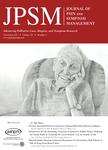版权所有:内蒙古大学图书馆 技术提供:维普资讯• 智图
内蒙古自治区呼和浩特市赛罕区大学西街235号 邮编: 010021

作者机构:Chinese Univ Hong Kong Fac Med Sch Pharm Shatin Lo Kwee Seong Integrated Biomed Sci Bldg Area 39 Hong Kong Peoples R China Chinese Univ Hong Kong Fac Med Nethersole Sch Nursing Hong Kong Peoples R China Chinese Univ Hong Kong Integrat Med Ctr Shatin Hong Kong Peoples R China Hong Kong Childrens Hosp Hong Kong Peoples R China Chinese Univ Hong Kong Fac Med Dept Paediat Shatin Hong Kong Peoples R China Chinese Univ Hong Kong Fac Med JC Sch Publ Hlth & Primary Care Shatin Hong Kong Peoples R China
出 版 物:《JOURNAL OF PAIN AND SYMPTOM MANAGEMENT》 (J. Pain Symptom Manage.)
年 卷 期:2025年第69卷第5期
页 面:e337-e358页
核心收录:
学科分类:1204[管理学-公共管理] 1002[医学-临床医学] 1001[医学-基础医学(可授医学、理学学位)] 10[医学]
基 金:Hong Kong Health Bureau Chinese Medicine Development Fund [23B2/072]
主 题:Traditional complementary and integrative medicine Pediatric palliative care Pain Psychological distress Meta-Analyses Systematic review
摘 要:Context. Traditional, complementary, and integrative medicine (TCIM) is being increasingly used to manage symptoms in patients with palliative needs. However, there is a lack of evidence to guide its use in the pediatric palliative care (PPC) setting. Objectives. This study aimed to synthesize and evaluate the current evidence on the effectiveness of TCIM in reducing pain and psychological distress in PPC. Methods. Four English electronic databases were searched for randomized controlled trials (RCTs) published between January 2000 and August 2023. The standardized mean difference (SMD) was used to report the pooled magnitude of the treatment effect. The Grading of Recommendations Assessment, Development, and Evaluation system was used to assess the quality of the evidence for each treatment outcome. Results. Thirty RCTs were included. The interventions were massage (n = 9), music therapy (n = 6), hypnosis (n = 3), acupuncture, aromatherapy, and other TCIM modalities. Compared with the control interventions, music therapy significantly decreased pain (SMD:-1.07;95% CI:-1.64 to-0.50;P 0.05;I-2 = 72%) and relieved anxiety (SMD:-0.75;95% CI:-1.35 to-0.15;P 0.05;I-2 = 74%);massage significantly decreased pain (SMD:-0.74;95% CI:-1.46 to-0.02;P 0.05;I-2 = 83%) and relieved anxiety (SMD:-0.61;95% CI:-1.21 to-0.01;P 0.05;I2 = 71%). Hypnosis had significant effects on procedure-related anxiety, pain, and behavioral distress management (P 0.05). The quality of evidence was rated as moderate for the efficacy of music therapy in alleviating pain and anxiety and low for the efficacy of all of the other interventions. Conclusions. Existing evidence supports the therapeutic benefits of music therapy, massage, and hypnosis on relieving pain and anxiety symptoms in the PPC setting, though the evidence is of low-to-moderate quality. (c) 2025 The Authors. Published by Elsevier Inc. on behalf of American Academy of Hospice and Palliative Medicine.